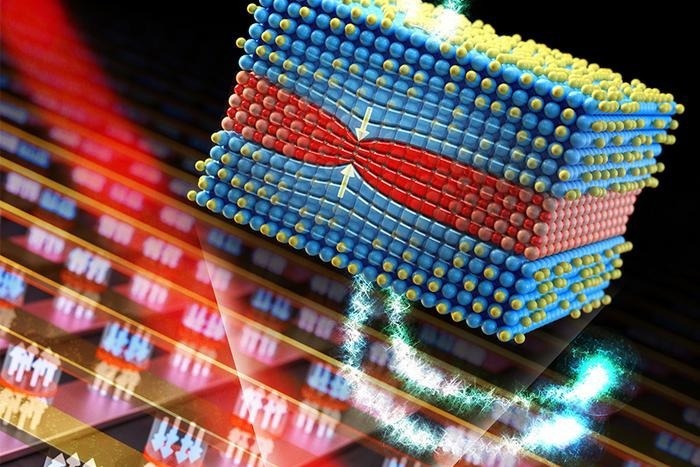Reviewed by Danielle Ellis, B.Sc.Sep 16 2024
Researchers at the University of Minnesota Twin Cities have conducted a new study that sheds light on how next-generation electronics, such as computer memory components, malfunction or deteriorate over time. Gaining insight into the causes of deterioration could enhance the effectiveness of data storage solutions. The study is highlighted on the cover of ACS Nano, a peer-reviewed scientific publication.
 For the first time, researchers were able to observe a “pinhole” within a device and observe how it degrades in real-time. Image Credit: Mkhoyan Lab, University of Minnesota
For the first time, researchers were able to observe a “pinhole” within a device and observe how it degrades in real-time. Image Credit: Mkhoyan Lab, University of Minnesota
The need for effective data storage solutions keeps rising as computing technology advances. Spintronic magnetic tunnel junctions (MTJs), nanostructured devices that use the spin of electrons to enhance hard drives, sensors, and other microelectronics systems, including Magnetic Random Access Memory (MRAM), are creating promising substitutes for the current generation of memory devices.
MTJs are the fundamental components of non-volatile memory found in devices like smartwatches and in-memory computing. They have the potential to be used in AI applications to increase energy efficiency.
Researchers examined the nanopillars—very tiny, transparent layers within the device—in these systems using a high-end electron microscope. To see how the gadget functions, the researchers passed current through it. They watched in real time as the device deteriorated and eventually died as they increased the current.
Real-time transmission electron microscopy (TEM) experiments can be challenging, even for experienced researchers. But after dozens of failures and optimizations, working samples were consistently produced.
Dr. Hwanhui Yun, Study First Author and Postdoctoral Research Associate, Department of Chemical Engineering and Material Sciences, University of Minnesota
Through this process, they were able to ascertain that the device malfunctions due to pinched layers resulting from continuous current flow. Theoretically, this has been studied before, but this is the first time the phenomenon has been observed. Once a "pinhole" or pinch forms in it, the gadget is in the early stages of deterioration. The device completely burns out and melts down as the researchers keep feeding it more and more current.
What was unusual with this discovery is that we observed this burn out at a much lower temperature than what previous research thought was possible. The temperature was almost half of the temperature that had been expected before.
Andre Mkhoyan, Study Senior Author, Professor and Ray D. and Mary T. Johnson Chair, Department of Chemical Engineering and Material Sciences, University of Minnesota
When examining the device in detail at the atomic scale, scientists discovered that tiny materials have radically different characteristics, such as melting points. This implies that the gadget will malfunction at a time that is entirely different from anything that has ever been known.
There has been a high demand to understand the interfaces between layers in real time under real working conditions, such as applying current and voltage, but no one has achieved this level of understanding before.
Jian-Ping Wang, Study Senior Author and Distinguished McKnight Professor and Robert F. Hartmann Chair, Department of Electrical and Computer Engineering, University of Minnesota
“We are very happy to say that the team has discovered something that will be directly impacting the next generation microelectronic devices for our semiconductor industry,” added Wang.
The researchers anticipate that by using this knowledge, computer memory units will be designed with greater longevity and efficiency.
The team also included University of Minnesota Department of Electrical and Computer Engineering postdoctoral researcher Deyuan Lyu, research associate Yang Lv, former postdoctoral researcher Brandon Zink, and collaborators from the University of Arizona Department of Physics, alongside Yun, Mkhoyan, and Wang.
Funding for this study came from the National Institute of Standards and Technology (NIST), Defense Advanced Research Projects Agency (DARPA), National Science Foundation (NSF), University of Minnesota Grant-in-Aid, and SMART, one of seven centers of nCORE, a Semiconductor Research Corp. program. The work was finished in cooperation with the Minnesota Nano Center and the University of Minnesota Characterization Facility.
Journal Reference:
Yun, H., et al. (2024) Uncovering Atomic Migrations Behind Magnetic Tunnel Junction. ACS Nano. doi.org/10.1021/acsnano.4c08023.